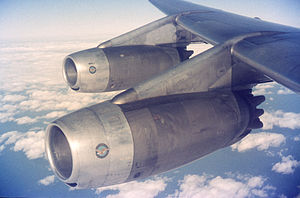|
Pratt & Whitney J75
The Pratt & Whitney J75 (civilian designation: JT4A) is an axial-flow turbojet engine first flown in 1955. A two-spool design in the 17,000 lbf (76 kN) thrust class, the J75 was essentially the bigger brother of the Pratt & Whitney J57 (JT3C). It was known in civilian service as the JT4A, and in a variety of stationary roles as the GG4 and FT4. Design and developmentIn military use, the J75 was used on the Convair F-106 Delta Dart, Lockheed U-2, and Republic F-105 Thunderchief. It was also utilized in the prototype and experimental Avro Canada CF-105 Arrow, Lockheed A-12, Martin P6M-2 SeaMaster, North American YF-107, and Vought XF8U-3 Crusader III. Before the arrival of the Pratt & Whitney JT3D turbofan engine, the JT4A was used to power certain Boeing 707 and Douglas DC-8 models, bringing improved field performance in the medium-range Boeing 707-220 and Douglas DC-8-20, and intercontinental range in the Boeing 707-320 and the Douglas DC-8-30. By late 1959, P&W had considered introducing a turbofan version of the J75, which was to have tentatively been named the TF75 or JT4D.[1] Apparently, little interest was shown by the aircraft industry, so the variant was dropped.[citation needed] Marine & power generationAfter its relatively short lifetime in the aircraft role, the JT4A found more enduring use in the naval role, where the FT4 was produced in a variety of models between 18,000 and 22,000 hp (13 and 16 MW). Well-known uses include the first all-turbine warships, the Canadian Iroquois-class destroyers, as well as the United States Coast Guard's Hamilton-class cutters, the 1970s-built icebreakers Polar Sea and Polar Star (each 3 engines in CODOG configuration), and it was considered for the US Navy's Asheville-class gunboat. The same basic powerplant saw much wider use as a peak demand power turbine running on natural gas. From its introduction in 1960 over 1,000 FT4s have been sold, with many of them still in operation for electrical generation. Outdated by modern standards, refits are available that add catalytic converters to lower their emissions. Variants
Applications
Specifications (JT4A-11)Data from Jane's All the World's Aircraft 1962-63,[2] Aircraft engines of the World 1966/67,[3] Flight:Aero Engines 1960[4] General characteristics
Components
Performance
See alsoRelated development Comparable engines Related lists Notes
References
External linksWikimedia Commons has media related to Pratt & Whitney J75. |
||||||||||||||||||||
